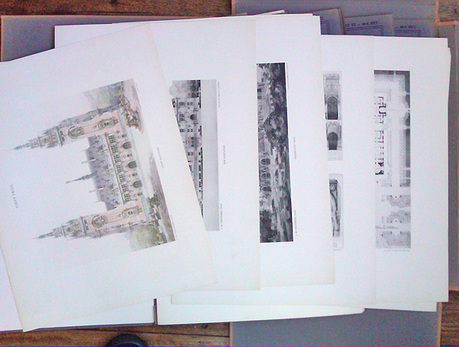
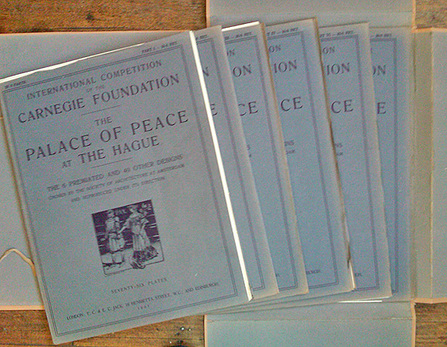

Palace of Peace. International Competition of the Carnegie Foundation. The Palace of Peace at The Hague. The 6 premiated and 40 other designs chosen by the society of architecture ... London, Jack 1907. Folio (49x38cm); eight parts loose as issued in publisher's printed wrappers and cloth portfolio (the portfolio a bit marked and bumped); 76 plates (eight colour) - elevations and plans. An excellent set. Au$600
A luxurious production. According to the report judging took several days, votes were close and there was some argument before Cordonnier's baroque wedding cake was given first prize, largely, the report suggests, due to its sympathy with surrounding buildings. Of the now revered competitors, Otto Wagner got fourth prize and Berlage and Saarinen were further down the lists. Despite stylish aspects of their designs and the idiosyncratic splendour of Debat's Indo-Mayan stupa - which looks to me like it could have inspired Burley Griffin's parliament house for Canberra - it does seem, from this distance, that the judges got it right. I'm sure they'll all sleep easier in their graves knowing that.
Cordonnier's building has a joyous optimism that matches the crusading zeal for world peace of patron Carnegie and any number of seemingly sensible exponents of world unity at the time. Wagner's building is an opulent museum or theatre, Saarinen's ideal for a mausoleum, Berlage's a Byzantine basilica, and most of the others studied lumps of classical monumentalism. Cordonnier's building did suffer paring down to meet budget and lost some of its airy charm but still ended up closer to the original design than many winners of other competitions.

NICHOLSON, Charles A. & Hubert C. CORLETTE. Modern Church Building. London 1907. Quarto publisher's printed wrapper; pp241-284, numerous illustrations and plans. Au$50
An offprint from the Journal of the R.I.B.A. An attempt to re-ignite some interest in the subject, given that 'ecclesiology was talked to death fifty years ago' and the 'last contribution to our subject which is of any considerable value was J.T. Micklethwaite's racy little book on modern parish churches'. This possibly refers to Micklethwaite's 'Parish Churches in the Year 1548' published in the Journal of the Royal Archaeological Institute, 1878. At least I hope it does.
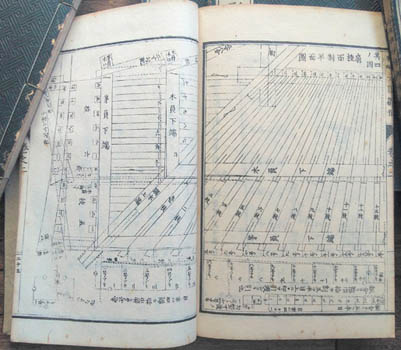
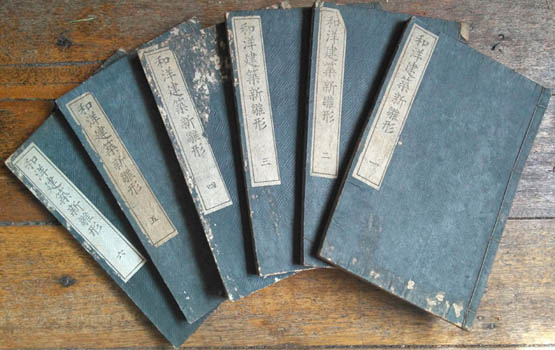
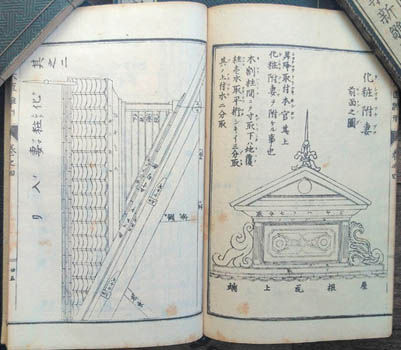
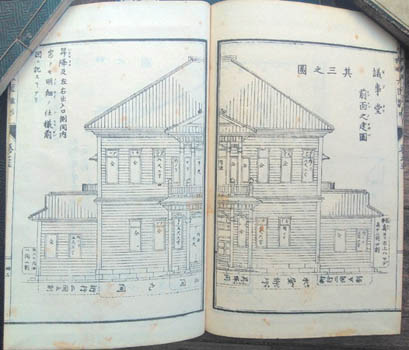

Kameda Yoshiro (or Kichirobei). [Wayo Kenchiku Shin Hinagata]. Osaka, Seikado 1907 (Meiji 40). Six volumes 22x15cm, publisher's wrappers with title labels; illustrated throughout with plans, elevations, measured drawings etc. Wrappers with some surface rubbing or insect grazing; a pretty good set. Au$850
I'm not sure whether this should be described as Japanese principles applied to western design or the other way round. I think both, if it matters. An excellent builder's pattern book that was certainly put to wide use.
There is a 2008 learned paper by Yanigasawa and Mizoguchi that shows how Kameda introduced Japanese carpentry and the modular system into western design but all except the precis of their paper is in Japanese so I have no idea how they go about proving their point. They do tell us that Kameda was a master carpenter in Fukuoka.
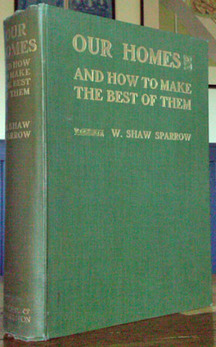
SPARROW, Walter Shaw. Our Homes and How to Make the Best of Them. London, Hodder & Stoughton 1909. Large stout octavo publisher's cloth; xii,280pp, 30 colour plates (six double page), numerous b/w photo illustrations, plans &c. A bit of spotting and a couple of minor flaws but quite a good copy of a book that didn't wear well. Au$100
A solid survey of what's up to date and fashionable, illustrating the work of Ashbee, Lutyens, Voysey, Newton, Brangwyn, Baillie Scott, Gimson, and others.
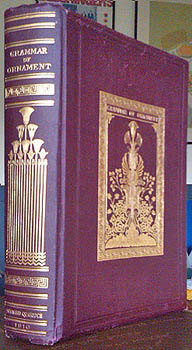
JONES, Owen. The Grammar of Ornament ... illustrated by examples ... London, Quaritch 1910 [reprinted 1928]. Small folio publisher's gilt decorated cloth; 112 colour plates including the extra title, illustrations through the text. Inner front hinge cracked but firm; cracking is common with this heavy book. A rather good copy. Au$450
The last proper edition, not as good as the 1860s editions but still a big step up from later reprints.
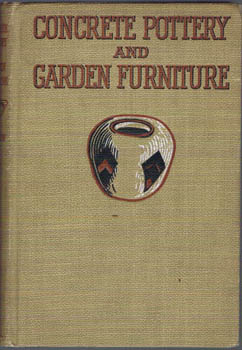
DAVISON, Ralph C. Concrete Pottery and Garden Furniture. NY, Munn 1910. Octavo, very good in publisher's decorated cloth; xiv,196p and publisher's list, 140 photo illustrations, diagrams and line drawings. Au$75
First edition. Exactly the sort of information which, in the wrong hands, leads to unspeakable evil. In general I'm in favour of knowledge for the masses and the unveiling of secrets held within cabalistic trades but this steps over the line. There isn't anything in here to take exception to, the examples are unremarkable, sometimes handsome, but I've seen too much of what happens when just anyone is given access to concrete and the means to knock up a mold.
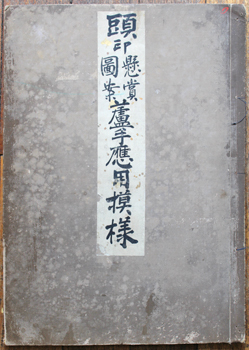
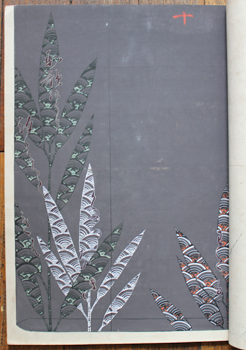
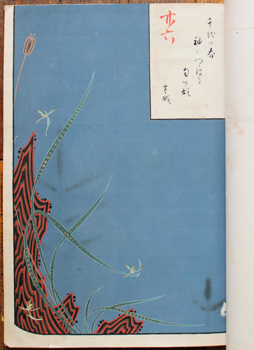
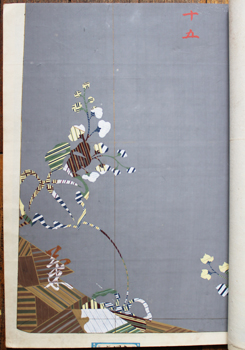

Kimono design. Shirokiyagofukuten? [Ashide Oyo Moyo?]. n.p. [191-?]. 54x39cm limp cloth with brushed title label; 30 original colour designs in gouache. A working book and pretty good for such a thing. Au$2000
A giant (comparatively) early 20th century set of finished designs for customers or maybe a pattern book; certainly they had a life before they were made into this book. They have been numbered one to thirty and some captions or annotations added at much the same time as they were painted. A couple have had a top corner cut out and a piece painted the same colour with the number and an annotation has been over laid. Two that had annotations that would have been cropped when the sheets were trimmed and bound have been retained, folded over. The subtitle above the main title translates more or less as 'pending designs'.
On the back cover is written Shirokiyagofukuten which was an Edo/Tokyo kimono seller, haberdashery, department store for about three hundred years until it petered out in the 1960s. These mostly plant based designs, though, and the pattern books which came from designs like this, seem much more Kyoto than Tokyo.
This is the second Shirokiyago album I've found. I'd like to think more might be out there but I won't hold my breath.

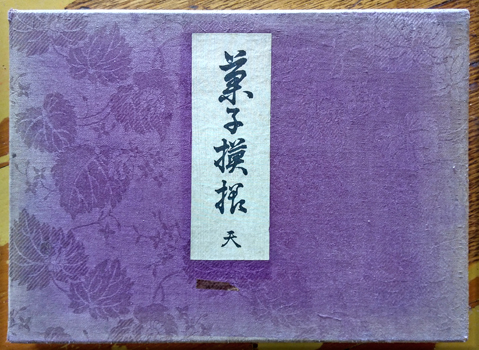
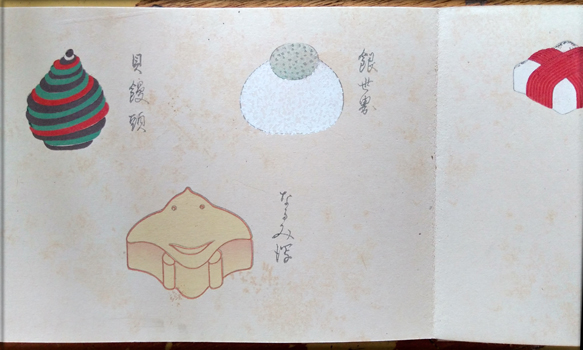


Confectionary. - [Kashi Moyo - Ten] Kyoto, Fujisawa 1912 (Meiji 45). 18x25cm publisher's silk with printed label (silk faded); 25 accordian folded card leaves with numerous colour woodcuts on 40 pages (two full page), text on the rest. Some browning or spotting but most acceptable. Au$500
Third edition? Three of these kashi albums were published in 1901 and 1902 covering heaven, earth and people, I think by the Kyoto sweetmakers association. Heaven is the theme for this offering of sweet designs. Books of kashi designs like this are known to date back to the late 17th century, there may have been earlier ones. They were produced by high class confectioners as catalogues for their high class customers. The text at the end apparently describes each treat. As you might expect their names are allusive and poetic: no 'custard tart' here, think rather of 'autumn wind'.
Kashi albums or pattern books blossomed in the late Meiji through to the early Showa - from about 1900 to 1930 - and I'm not sure why. I wonder if it was a fad inspired by someone like the crown princess having a passion for these elaborate sweets.
Worldcat finds one entry for this outside Japan and none of the others.
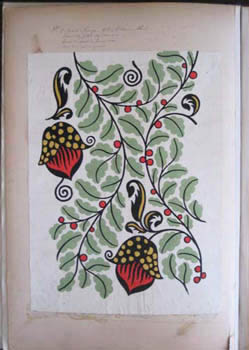

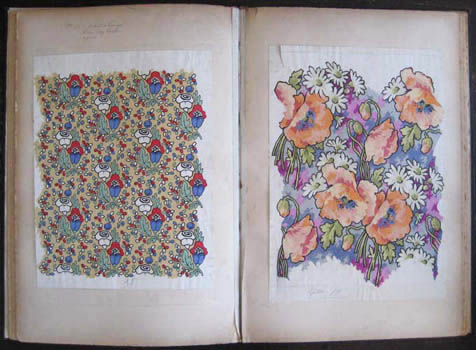


Design. An album of designs for textiles and/or paper. c1913-1920's? Large folio cloth [620x430mm]; 24 card leaves with 39 mounted original colour block prints (3 double page). Expected signs of use but nothing drastic; one print removed. Au$1200
Doubtless the designer's album of designs, these are proof prints from the blocks, each show the shape where the repeat pattern fits. The first pages are annotated with details of the client ('Achete a George. 9 Rue St Fiacre Paris' - in earlier decades this was the home of a calico manufacturer, which makes sense, and now houses a public relations firm and Ella Bache, which is neither here nor there) and the engraver (Gillet, sometimes in concert with someone else); the details dwindle as the album proceeds until we reach the large and dramatic geometric design in black and white which was "vendu a Mrs Bosset".
Dating these designs to 1913 would seem foolish but for the first few leaves being dated 1913 in the top corner; two or three are dull, traditional floral patterns but the rest, while by no means radical avant garde, would sit more happily in the next decade or two - some are really quite stylish. The theme is floral, or at least botanical although one is based on a Chinese cloud pattern; several are oriental in style or inspiration and one is a very stylish piece of Japanese abstraction.
I'm pretty sure this is the work of a Japanese designer in Paris, partly because it most recently came from Tokyo and partly because of the modern simplicity of several designs.
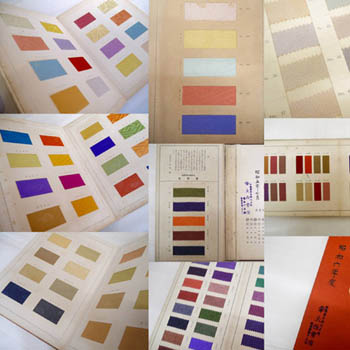
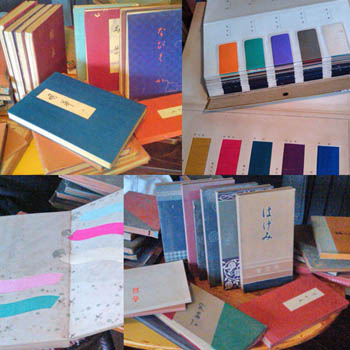
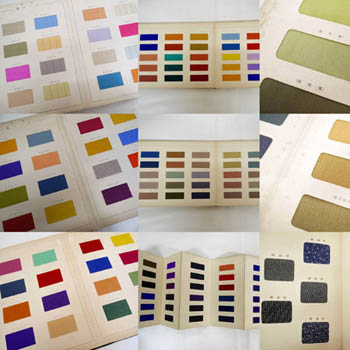
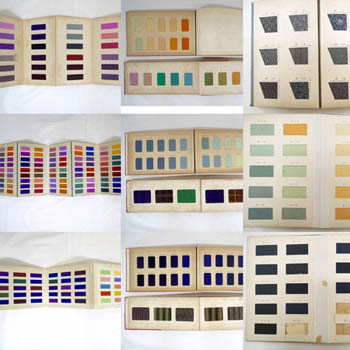

Kyoto Silk. A collection of 48 and a half large sample books of Kyoto silk from the twenties and thirties. Kyoto Orimonoshodo Meikai &c, c1920 to 1940. Various sizes corresponding to quarto or small folio, publisher's cloth or silk with stamped or paper label titles, some still in their card slipcases. Thousands of fabric samples mounted in window card leaves. These were, I'm told, in the family storehouse for decades and insects have sampled several covers and occasionally worked their way into the card leaves. A few covers show signs of mild damp but nothing drastic and there is general dustiness and some browning of card leaves - again nothing drastic - and all but one or two fabric swatches are in excellent shape. There are, out of however many thousand swatches in 48 volumes, perhaps a half dozen missing. The 49th - the half referred to - has about half of its 144 samples removed. Au$7200
These belonged to the Onishi Gofukumise, the Onishi Drygoods Store - kimono drapers of Uchika in the Ehime prefecture - a company that still exists in modern premises in the area. Their stamp is in many volumes and sometimes they have added a date stamp or written in the date, ranging from 1923 to 1938. All are from Kyoto, most under the banner of the Kyoto Orimonoshodo meikai - the textile merchants association. Lists of the member textile firms appear in some volumes.
The album titles, those I've been able to decipher, are not much help to me. They seem to be evocative or aspirational - much like the work of contemporary colour namers who label a colour 'harmony' instead of brown and 'hushed loam' rather than shit brown. Perhaps a textile expert will know that 'Encouragement', 'Mikado', 'Star' and 'Maple' (my approximations), if not trade marks, are particular ways of weaving or dyeing.
The first thing that struck me looking through these is the quality of book production. Many of these, most of these, are books produced with the same care as the best Kyoto design albums by publishers like Unsodo. There's nothing flimsy or slipshod; these books took a lot of time and care to make.
I don't like to boast but I can honestly say I know near as much about silk weaving as I do about playing the pedal steel guitar. Most of these seem to focus on the new season colours rather than patterns, though patterns are certainly there, but the weaving styles aren't by any means plain. There are creped silks, ribbed silks, damask like patterns and other esoteric textures produced by whatever occult means Japanese weavers used to make light play in different ways over the fabric.
Whether it's the pre-war born generation dying off or economic shift, a lot of fabulous textile stuff - design and sample albums - of the late 19th and early twentieth century has come out of Japan in the last few years. I've bought some and watched with hungry eyes much more go by and I notice it's slowed to a trickle. I'd like to think there's more to come but I suspect those old company and family storehouses have been pretty much emptied. I doubt another cache as rich as this, so specific to place and time, will be along anytime soon.
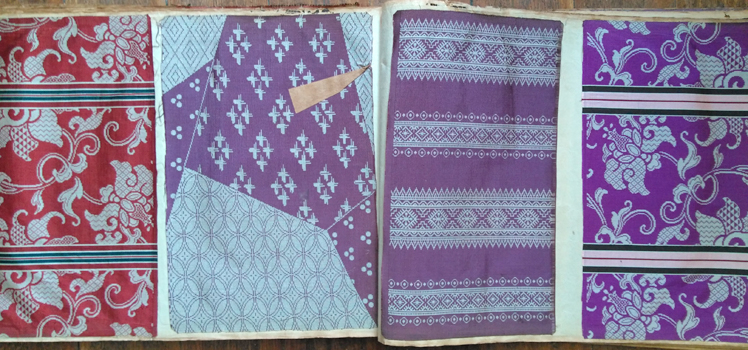
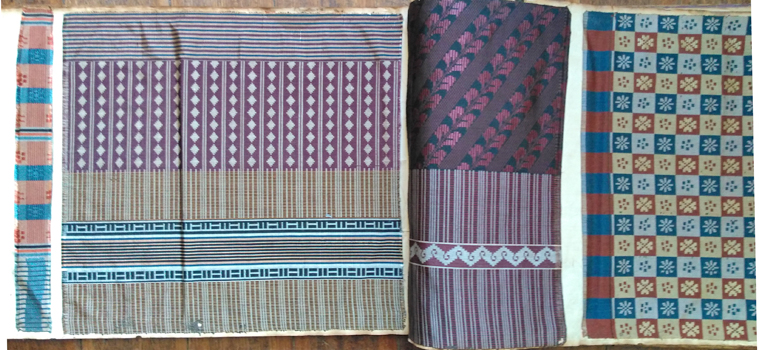
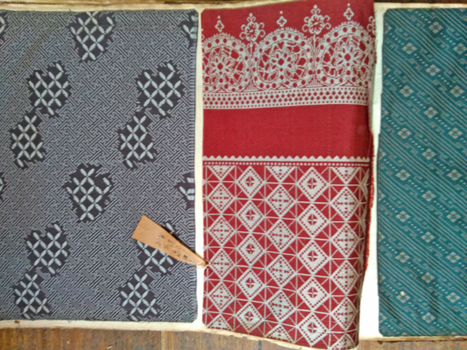


Japanese textiles. Sample book of woven ribbed silk and brocades for decoration and furnishing. n.p. late 19th, early 20th century. 35x48cm stitched with card wrapper on the back, front wrapper gone but contents complete; 113 samples on both sides of 33 leaves, several more blank leaves. Thoroughly used, staining of the paper but the textiles in good shape. On the back cover is the name Takahashi Masajiro or Seijiro. Au$1300
Size does matter. Small can be elegant and fetching but, with things like this, big is best. Several of the samples cover the full page and all the others are plenty big enough to get the full effect of colour and pattern.
Very much a working haberdasherer's sample book, several still have attached paper tags with handwritten numbers and descriptions and a few have small pieces of contrasting or harmonising fabric pasted on for effect. I've seen heaps of Japanese sample books for dress fabrics of all kinds but I don't remember ever seeing an unequivocal furnishing fabric book anywhere near this date. I'm too ignorant to know how and where these fabrics were used; to me they they seem too bold for scrolls and screens and I wonder whether heri - the binding of tatami - is one use. Heri was, I'm told, a significant indication of wealth and class. Still, these are modern fabrics - they are jacquard woven - at a time when western and traditional rooms could sit side by side in one house.
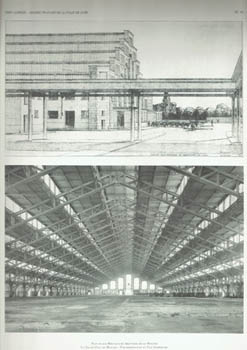
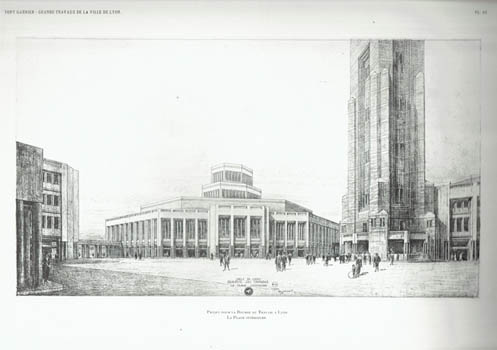

GARNIER, Tony. Les Grands Travaux de la Ville de Lyon. Etudes, projets et travaux executes. Paris, Massin [1920]. folio, loose as issued in publisher's portfolio of cloth backed printed boards; 12pp and 56 plates - drawings, plans, elevations and photos. Au$1200
In Garnier's work in Lyon, instigated by the mayor Edouard Herriott from 1906 on, he realised many of the ideas set forth in his Cite Industrielle and some of the ideas in Cite Industrielle came from his work in Lyon. Une Cite Industrielle was largely finished by 1904 but not published until 1918 so he had the chance to plug a few of the gaps in his imagined city from his real city. Some projects here were completed in later years and some never realised.

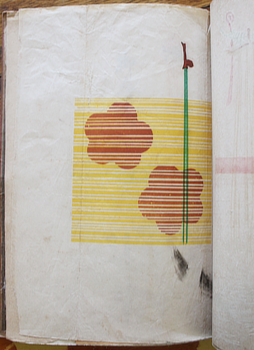
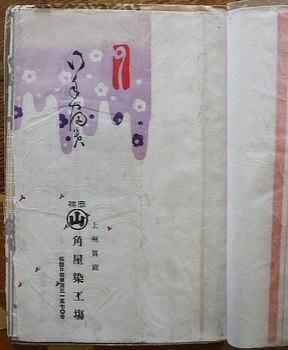


Noshigami. A sample book of Noshigami - special paper for gifts - from the Kadoya Dyeing Workshop, Tokyo. Tokyo [1920s?]. 24x18cm, home made printed stiff wrappers; 105 leaves of colour printed samples on different kinds of paper, various sizes. Au$400
Noshi-gami is specially printed paper to be folded and attached to gifts as I understand it. The ineluctable beauty of some patterns is enhancedher, I say, by being in a quite smart cover decorated with locomotives.
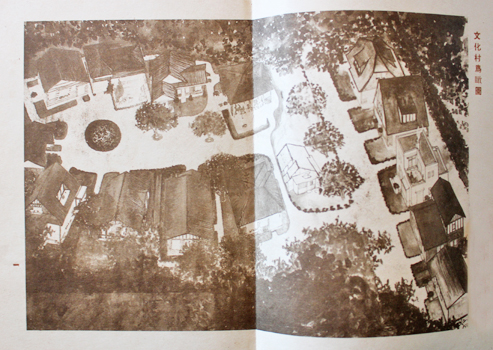

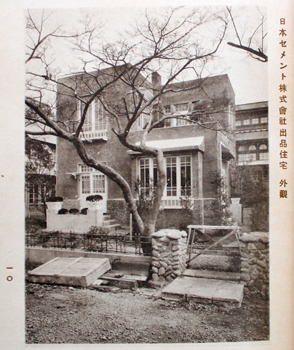
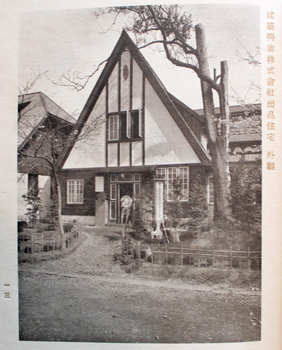

Takanashi Yoshitaro [ed]. [Bunkamura no Kan'i Jutaku]. Tokyo, Koyosha 1922 (Taisho 11). 19x15cm, publisher's stiff wrapper with mounted illustration; title, 19pp of text and 54 plates printed on one side: photo illustrations, floor plans and renderings, one double page. Some marks and minor signs of use. Au$300
Fourth printing, two months after the first, of this architectural guide to Japan's model Culture Village (Bunkamura) of 'simple' housing built for the 1922 Peace Exposition; the purposeful introduction of idealistic westernised homes, rather than mansions and commercial buildings. Western mostly on the outside, not so much inside. Fourteen houses were built by different builders that had to meet 15 guidelines which did not stipulate that the outside had to be western but did demand windows rather than shutters and paper screens and that decoration should be avoided. Living spaces had to be chair style and kitchens and bathrooms thoroughly up to date. After that it was up to the designers and builders and the results are what's usually called ecleticism, hybrid, or borrowing, but isn't so simple in intent. And, as usual, what was borrowed from the west was often a reclamation of what the west had borrowed from Japan: arts & crafts in England, craftsman in America, nouveau, seccesion, werkstatte, and whatever else in Europe.
At much the same time as this, across town another Bunkamura - the Mejiro Bunkamura development by Tsutsumi Yasujiro - was being launched, reportedly inspired by the streetscape of Beverly Hills. The houses in both villages were for the new middle classes but Tsutsumi's village was for the upper middle class. Much of what was built during the twenties was destroyed during the war but the remaining fragments show shared characteristics which I'd say, from the bit I've read about him, had nothing to with any idealism in Tsutsumi.

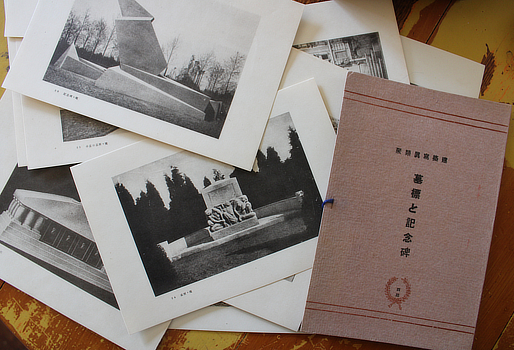
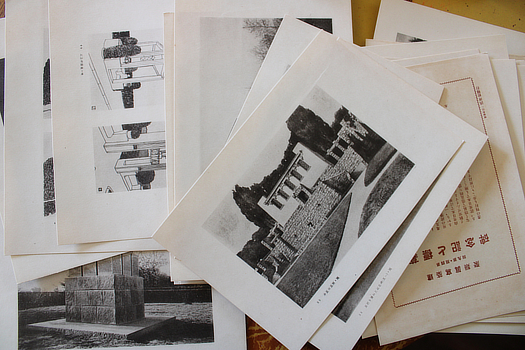
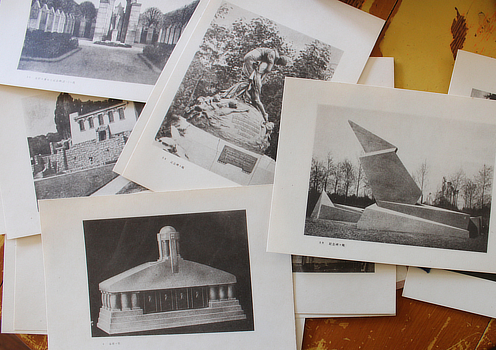

[Bohyo to Kinenhi]. Tokyo, Koyosha 1923 (Taisho 12). 19x13cm, loose as issued in publisher's printed boards; 50 leaves, mostly plates printed on one side. An excellent copy. Au$100
One of the apparently endless series of small architecture monographs, Kenchiku Shashin Riuju. I wonder if anyone knows how many there were. Some are intriguing and some are pretty drab. Many require a dogged love of gateways and tea rooms. This one is pretty good.
Gravestones and memorials, a good mix of old school kitsch and moderne, a few to the edge of extreme. They can be examples of pure design, being free and limitless, as the foreword says, and here are offered as a lesson to Japanese to reform their gloomy and sad approach to marking their dead in the landscape.
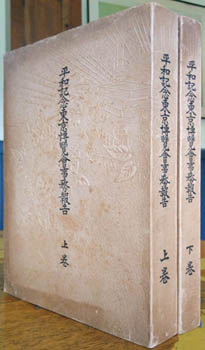

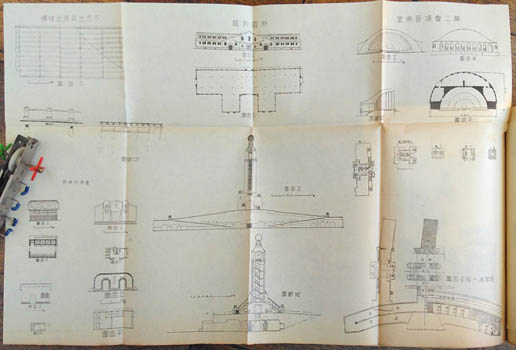
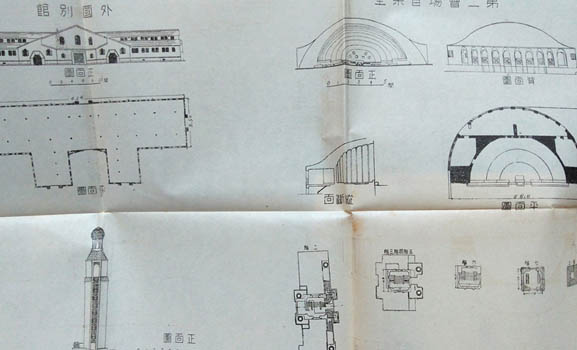

Exhibition - Tokyo 1922. [Heiwa Kinen Tokyo Hakurankai Jimu Hokoku]. Tokyo Fucho 1924 (Taisho 13). Two volumes 26x19cm, publisher's embossed wrappers (browned); 681pp, heaps of illustrations: folding colour plans, architectural elevations and plans, photo plates, etc. Browning and foxing expected from the paper but still a rather good fresh copy. Au$1350
The official report on the 1922 Tokyo Memorial Peace Exposition is the very model of what an official report on an exhibition should be. You could just about rebuild the whole thing from this. The detail extends to measured drawings of light fittings, plans of the garden beds and coloured reproductions of the tickets and advertising.
The 1922 Peace Memorial Exhibition, celebrating the League of Nations and a bright future, was the most lavish national Expo ever held. The pavilions were a mix of stately, ultra modern and funfair fairy tale.
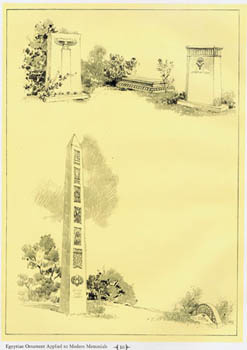
HOPKINS, Henry Powell. Sources of Memorial Ornamentation. Vermont Marble Company 1924. Quarto, very good in publisher's gilt decorated boards, cloth spine; 44pp, 14 plates. Au$75
Something of a trade catalogue:- a primer of the basic styles - Egyptian, Greek, Roman, Celtic, Gothic and Colonial - with suggestions for their application to modern gravestones.
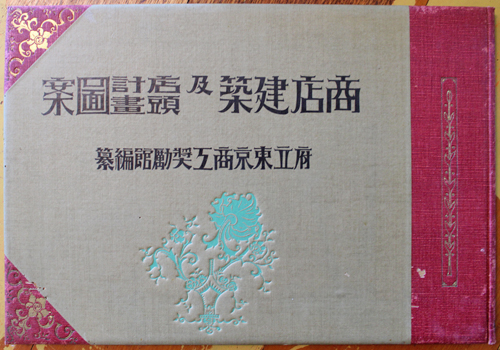
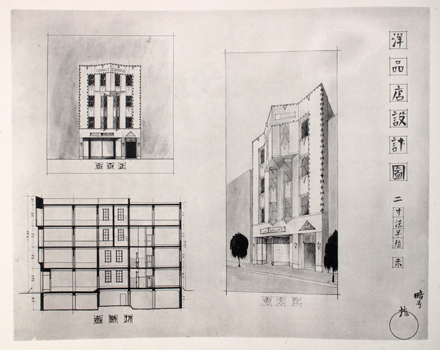
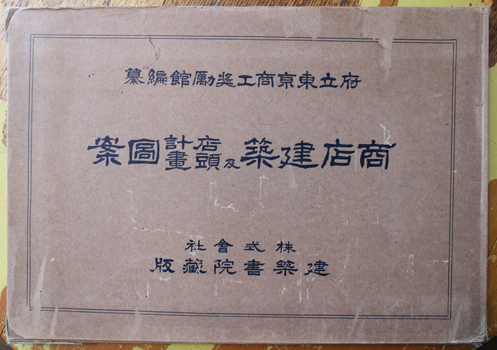
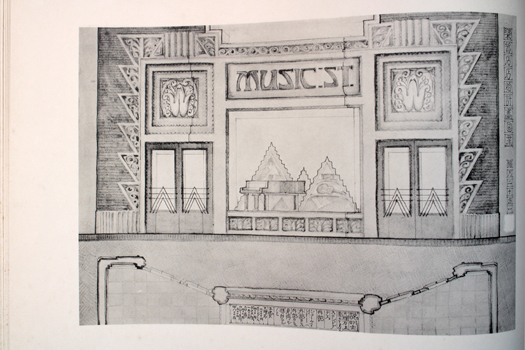

Shop architecture. [Shoten Kenchiku Oyobi Tento Keikaku Zuan]. Tokyo, Kenchikushoin 1924 (Taisho 13). Oblong folio, 26x39cm publisher's decorated cloth (a couple of nibbles) and mildly battered printed card case; [10]pp, 50 b/w plates, [4]pp. A nice copy. Au$1350
Modern and moderne shop buildings and store fronts; essential if you want to rebuild Tokyo after the earthquake and before the fire bombing. This is, of course, part of the post earthquake reconstruction effort: the results of a competition held by the equivalent of the Tokyo chamber of commerce. The plates, elevations and floor plans, are reproduced from measured drawings and look ready to build but I wonder about one (by Shibahara Niro) which, the facade at least, seems to be taken straight from Bruno Taut's crystal alpine architecture. The requirements: frontage, height etc, are spelt out in the introduction and I presume fit an average commercial lot. At the end are designs for shop fronts.
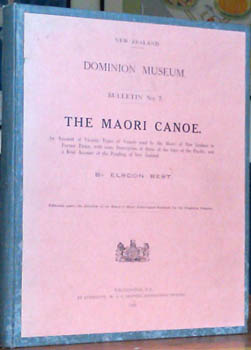
BEST, Elsdon. The Maori Canoe. An acount of various types of vessels used by the Maori of New Zealand in former times, with some description of those of the isles of the Pacific ... Wellington, Govt Printer 1925. Quarto contemporary cloth (lightly flecked) with the original printed wrapper mounted on the front board; vi,312pp, map, some 170 photo illustrations, line drawings and diagrams. Dominion Museum Bulletin No.7. Au$200
The definitive work, it isn't superceded by Haddon's 'Canoes of Oceania' but forms a good companion. Best covers everything from tree felling to decoration and investigates the history of Polynesian migration.

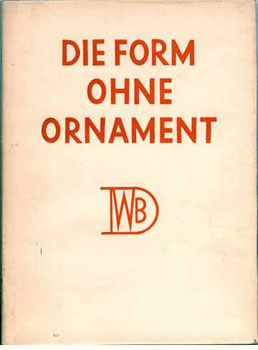

[Werkbund]. PFLEIDERER, Wolfgang [ed]. Die Form Ohne Ornament. Werkbundausstellung 1924. Stuttgart, Deutsche Verlags 1925. Quarto, excellent in publisher's cloth and dustwrapper; viii,22pp, photo illustrations on 89 plates and adverts. Au$200
Third and fourth thousand. The Werkbund displayed for 1924: from soap to gravestones, cutlery to satchels.
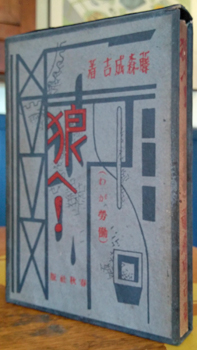
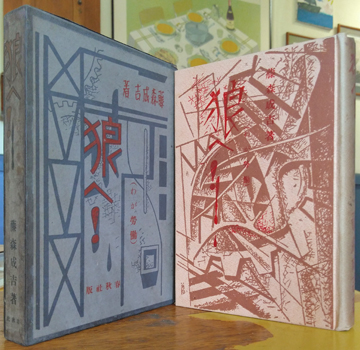
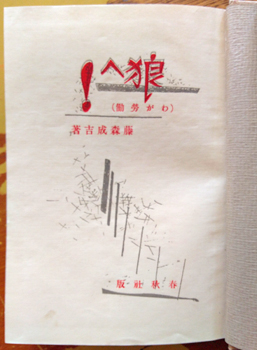
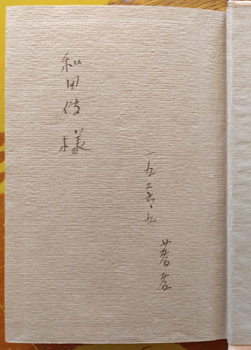

Yanase Masamu & Fujimori Seikichi. ( ) [Okami e! (Waga Rodo)]. Tokyo, Shunjusha 1926 (Taisho 15). 20x14cm, excellent in publisher's illustrated boards and slipcase by Yanase. Spine a bit browned, minor wear to the top of the slipcase; rather good. Inscribed and signed by Fujimori in September 1926 to the novelist Wada Den (Wada Tsuto). Au$600
First edition of Fujimori's proletarian novel - the title translates as 'To the Wolf! (my labour)' - but, alas, probably more wanted for Yanase's book design these days. As I can't read the book, there's no contest for me. Both were trouble makers and both ended up in trouble - jailed every now and again, in Yanase's case tortured as well.
Yanase, both prodigy and prodigious, was one of the founders of MAVO - now Japan's best known avant-garde group of the early twenties - after membership of futurist and constructivist associations and before moving onto self proclaimed proletarian movements. He abandoned painting in the late twenties - the fine arts were anti-proletarian - and worked only as a graphic artist until the war, which he did not survive.
Wada Den was prominent in the school of farmer or peasant literaure. They both wrote about the working class but Wada was, I've read, no friend to left wing troublemakers.
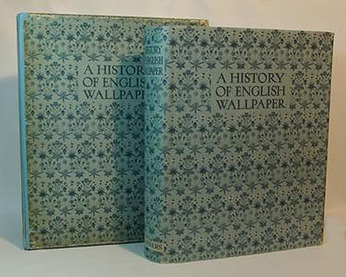
SUGDEN, Alan Victor & John Ludlam EDMONDSON. A History of English Wallpaper 1509 - 1914. NY, Scribners, London, Batsford [1926]. Hefty quarto, excellent in publisher's gilt cloth, dustwrapper and dropfront box (the hinges and corners of this sometime strengthened and a title label added to the spine). xiii,281pp, 70 mounted colour, numerous photo plates. A most appealing copy and Cecil B. De Mille's copy with his Iribe bookplate. Au$500



Shogakusei Zenshu. Murayama Tomoyoshi. [Ongaku no Hanashi to Syokashu]. Tokyo, Kobunsha 1927 [Showa 2]. Octavo, cloth backed publisher's illustrated card wrapper; one colour plate, b/w illustrations throughout. Some browning and mild signs of use; a rather good copy. Shogakusei Zenshu no.67. Covers - front and back - by Murayama Tomoyoshi. Au$125
The Shogakusei Zenshu, or Complete Works for Elementary Schools, runs to some 88 volumes of educational texts and literature - much of this in translation; few of them seem elementary. This one covers music. Murayama maybe leads the list of avant-garde heros of interwar Japan. Founder of MAVO and communist troublemaker he had books and plays banned, ended up in prison and produced lively, humourous illustrations for children.
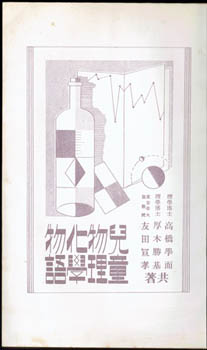
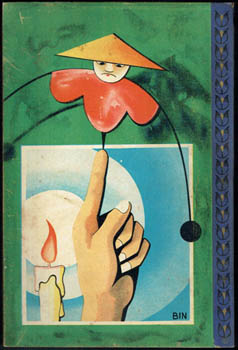

Shogakusei Zenshu. [Jido Butsuru Kagaku Monogatari]. Tokyo, Kobunsha 1928 [Showa 3]. Octavo, cloth backed publisher's illustrated card wrapper; illustrated title, two colour plates, photo and b/w illustrations through the text. Some browning and mild signs of use; a rather good copy. Shogakusei Zenshu no.61. Cover by Michioka Toshi. Au$90
The Shogakusei Zenshu, or Complete Works for Elementary Schools, runs to some 88 volumes of educational texts and literature - much of this in translation; few of them seem elementary. This one is physics and chemistry.
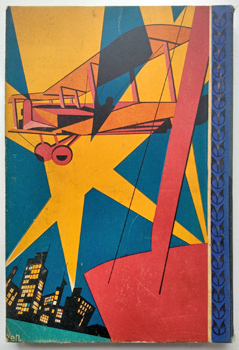
Shogakusei Zenshu. Maekawa Senpan. - [Hikoku no Hanashi - Sensuikan no Hanashi]. Tokyo, Kobunsha 1928 [Showa 3]. Octavo, publisher's cloth backed illustrated card wrapper by Maekawa Senpan; illustrated title, one colour plate, photo and b/w illustrations. Minor signs of use, quite good. Au$135
The Shogakusei Zenshu, or Complete Works for Elementary Schools, runs to some 88 volumes of educational texts and literature - much of this in translation; few of them seem elementary. This one covers the aeroplane and the submarine.
Maekawa started as a cartoonist and became a founding member of the Sosaku Hanga movement. Like many of his generation he continued to make his living as a commercial illustrator. Here he outshines many of his most celebrated prints.
  1 [2] 3 4 1 [2] 3 4   |